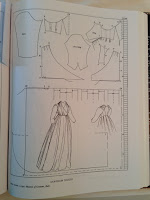For August's Heirlooms & Heritage challenge,
First, the finished challenge, a Regency Pelerine!
 |
| Regency Pelerine by TheLadyDetalle |
My family history (like most people's) is intriguing and varied in location and time periods, and whether you are looking at the male line or the female line (of direct descendants) or the side family lines, etc. My family history includes Massachusetts near the water, and would have been cold and even bitter cold at times and warm during summer. Without any specific pictures of relatives prior to turn of the century (1905 or so), I had to go with more what they 'could have worn' versus what they actually wore. Hence, the Regency pelerine, a fashion from the early 19th century meant to keep warm during cold months: a pelerine is outerwear that is waist length in back, and long in front, with my fashion print example going to a point in front. I decided for August's Heirlooms & Heritage challenge, that I would re-create a pelerine from the time that my relatives in MA could have worn about 1805!
Here is my original inspiration fashion plate:
 |
| Fashion plate inspiration - pelerine |
Here are a few pelerine in-progress pics:
 |
| Cutting out the silk taffeta pelerine (on the fold) |
 |
| Cutting out 2 1/2" pelerine bias silk binding |
 |
| Pelerine & pelerine lining pinned and bia binding strips ironed & ready |
 |
| Pelerine with hand sewn bias binding |
Historical Sew Monthly AUGUST challenge:
The Challenge: Heirlooms & Heritage: Re-create a garment one of your ancestors wore or would have worn, or use an heirloom sewing supply to create a new heirloom to pass down to the next generations.
For this challenge, I re-created a garment one of my MA ancestors COULD have worn in the early 19th century, a Regency pelerine!
Fabric: cream silk taffeta from the stash (silk sale from GoldenSilks.net) and lavender silk from the stash (Jomar).
Pattern: no pattern. I draped/drafted this using my late 18th century hooded cape base as a starting point, then pinning and shaping, making up 2 muslins before I was happy with the shape/fit! I ended up cutting one long piece on the fold.
Year: early 19th century, about 1805
Notions: white marabou feather boa trim from JoAnn's.
How historically accurate is it? It's very historically accurate. I based this directly on a fashion plate example, simply changing the color of fabric and trim a bit. I hand sewed everything (minus a hidden machine sewn tiny seam allowance to hold together the top fabric and the lining until I could hand sew it together with cream silk taffeta bias binding.
Hours to complete: 1.5 hours to drape the pattern, a few hours to cut out fabric/lining and cut out & iron bias binding. An hour to pin on bias binding and a few hours to sew bias binding on. Sewing on the marabou trim is a pain and took a lot of hours, probably 12 hours. Or more.
First worn: not yet! I'm planning on wearing this some time this fall/winter, but not 100% sure which outing yet - a few upcoming Regency costume events in this fall, so likely one of those!
Total cost: all fabric and trim/notions came from the stash! Cream silk taffeta was on sale for $7 a yard (plus $1.50/yd s&h) and lavender lining was $5 a yard. I used about 3 1/2 yards of silk taffeta (and I pieced the lining a bit; you need 3 1/2-4 yards to cut the silk taffeta in one piece on the fold, and to cut bias cut binding - but I had plenty of fabric left over still). Marabou trim was $5.99 each (I used 4) but I bought them using 20-40% off coupons from JoAnn's.
Next up is September - Colour Challenge Brown






























